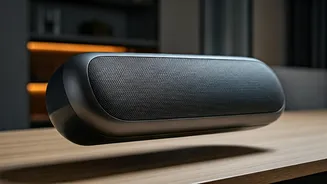What Are They?
Smart speakers are essentially voice-activated devices that integrate with the internet, allowing users to perform various tasks using voice commands.
Initially designed to play music, these speakers have become much more versatile over time. They are equipped with microphones to pick up voice prompts, speakers to deliver audio feedback, and software that processes voice commands to provide information or initiate actions. Early models focused on basic functions like playing music or setting alarms. Today’s smart speakers offer far more comprehensive features, providing services like news updates, weather forecasts, and control over smart home devices. This means you can adjust your thermostat, turn on lights, and lock doors, all through voice commands.
Core Functionality Explained
The underlying technology of smart speakers relies heavily on Artificial Intelligence (AI) and Natural Language Processing (NLP). When a user speaks a command, the speaker's microphones capture the sound, and the NLP software analyzes the speech. The device then interprets the user's intent, retrieves relevant information, and responds appropriately. For example, if you ask a smart speaker to play a song, the system identifies the request, accesses the music streaming service, and starts playing the requested track. Similarly, if you ask for the weather forecast, the speaker connects to a weather service, gathers the latest data, and relays the information through audio. These speakers can also learn from user interactions, becoming more accurate and personalized over time. By analyzing usage patterns and adapting to user preferences, they offer an increasingly tailored experience.
The Ecosystem's Impact
Smart speakers have fostered the growth of a broader ecosystem that integrates home automation. Many models support integration with various smart home devices, allowing users to control their appliances through voice. This includes lights, thermostats, door locks, and security systems. The ability to control different devices through a single, centralized interface enhances convenience and efficiency. Homeowners can create custom routines, setting up automated actions that trigger based on time, voice commands, or other events. Smart speakers also serve as communication hubs. They enable hands-free calling, messaging, and announcements within the home. This functionality is particularly useful for families to stay connected. The expansion of these features has contributed to an increased adoption of smart speakers and a transformation in how people interact with their living spaces.
User Experience Matters
User experience is at the core of smart speaker design. Manufacturers focus on creating intuitive and accessible interfaces. The initial setup process typically involves simple steps, such as connecting the device to a Wi-Fi network and linking it to a user's account. Voice interaction is the primary method of control. Speakers are designed to recognize and respond to a wide range of commands, making them easy to use for all age groups. Voice feedback plays a crucial role. Clear and concise audio responses confirm that commands have been received and executed correctly, reducing frustration and confusion. Manufacturers also prioritize design aesthetics. Smart speakers are available in various styles, sizes, and colors, allowing them to blend seamlessly into different home environments. This combination of ease of use, seamless integration, and appealing design is essential for enhancing user satisfaction and driving broader adoption.
Privacy and Security
The increasing use of smart speakers has raised important privacy concerns. These devices are constantly listening, which means they can potentially record private conversations and collect personal data. Security measures have been developed to protect user information. Most smart speakers offer features like microphone mute buttons, which allow users to physically disable the device's listening capabilities. Companies also provide settings that allow users to review and delete their voice recordings, giving them greater control over their data. It's crucial for consumers to understand the privacy policies associated with smart speakers. They need to make informed choices about what data they share and how it is used. As smart speakers evolve, ongoing efforts are needed to balance functionality with privacy and security. This will ensure that users can enjoy the benefits of smart home technology without compromising their personal information.
Future Developments
The future of smart speakers is likely to bring exciting advancements. We can expect improvements in voice recognition and natural language processing, making interactions more seamless and intuitive. Enhanced audio quality and immersive sound experiences, combined with spatial audio, will become standard, enhancing the entertainment value of these devices. Integration with other technologies will also deepen. Smart speakers will likely interact more seamlessly with virtual reality (VR) and augmented reality (AR) platforms, creating richer, more interactive experiences. The convergence of smart speakers with other devices, such as smart displays, will lead to more versatile and user-friendly products. Innovations in AI will play a critical role, enabling smart speakers to provide more personalized recommendations and anticipate user needs. Continued focus on user privacy and security will be essential to ensure consumer trust.













